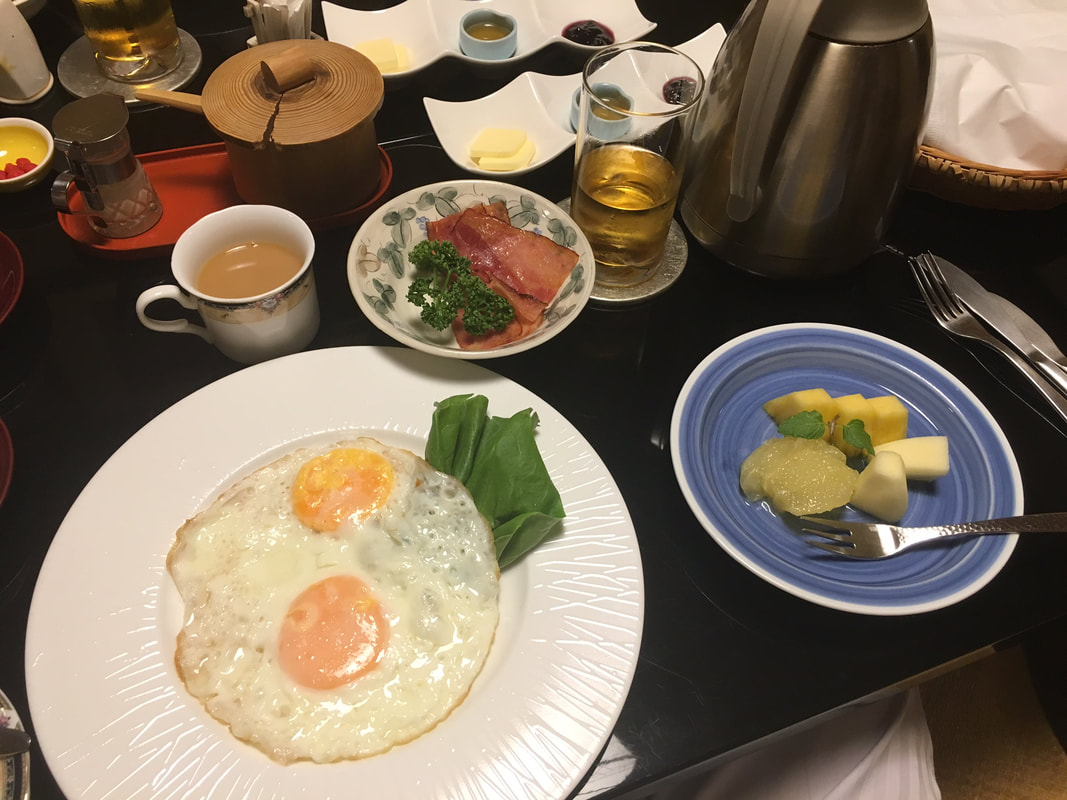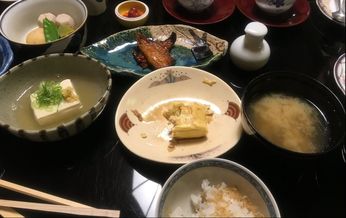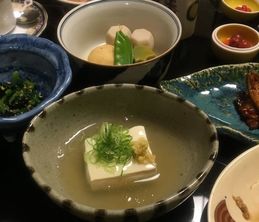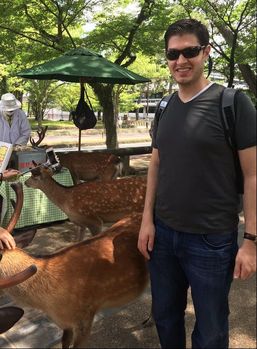|
When staying at a ryokan or other lodging facility, may have a choice of breakfast options. Often times there will be a traditional Japanese breakfast and western style alternative. The western style breakfast is similar to what you may find in the United States or Europe. You should expect some combination of eggs, fruits, and meats. Other options may include pancakes, waffles, or toast. Juice, tea, and coffee are common breakfast beverages as well. The western style breakfast pictured contains fried eggs, fruits, ham, bread, juice, and coffee. A selection of butter, jam, and honey was provided for the bread. Expect the breakfast items to change depending on the season or even daily at a ryokan. If your lodging does not serve breakfast, you can find western style options at local cafes and restaurants. Ryokans offer many opportunities to enjoy Japanese culture and cuisine. Some ryokans offer their guest the option of ordering a traditional morning breakfast served in their room. While it is not an inexpensive option (around $25 per day), a traditional breakfast is certainly worth trying. If you are not interested in a traditional breakfast, most ryokans offer a western style option with items you would normally expect. Keep in mind that breakfast items can vary by day and season. You may not know what you are ordering until it actually arrives. One of the unique aspects of a traditional breakfast is how everything is served. Each item is a small portion put into separate dishes. The breakfast usually includes fish, rice, vegetables, and tea. Expect a mixture of hot and cold seasonal items. The entire breakfast can vary in size depending on your ryokan and what they have available. The next time you stay at a ryokan, remember to order a traditional breakfast for an adventurous and delightful experience. Below is a list of the items pictured:
The city of Nara, Japan is located east of Osaka, Japan and south of Kyoto, Japan. It can be reached by about a 50 minute train ride from Osaka or an hour train ride from Kyoto. Nara is well known for the Todai-ji Buddhist temple. While the temple and its statute of Buddha are well worth seeing, many tourists also enjoy visiting the Nara deer. What are Nara Deer? The deer found in Nara are known as sika deer. The deer are wild and are a protected species in Japan. You can find sika deer in other locations across Japan such as Miyajima Island. The deer in Nara are fairly tame and used to people visiting the area. Where can I see Nara Deer? The Nara Deer can easily be found at Nara Park. The easiest way to reach Nara Park by train is to get off at Kintetsu-Nara Station and head directly east. You will pass by Nara Park while heading towards Todai-ji temple. Can You Touch or Feed Nara Deer? There are special crackers available for sale around Nara Park to feed the deer. You are not supposed to feed them anything else. Use caution if you want to pet them as they are wild animals. Nara Park in Nara, Japan
One of the main benefits of staying at a ryokan is the opportunity to experience a hot spring bath, commonly known as an onsen. The onsen is typically an included amenity for guests to using at a ryokan. The bath hours can vary, but expect it to be available in the morning and evening daily. Men and women have their own separate bath areas. What to Expect in an Onsen Area When you step inside the bathing area, there is an area to store your robe, slippers, and other belongings in a basket or other container. Towels are available for use after bathing. You should find a sink, mirrors, hair dryer, and other items for grooming and drying off after using the bath. Near the actual bath, you will find stalls for rising off and showering. A stool and bucket along with soap and shampoo should be provided. What to Wear and Bring to an Onsen Area The proper attire for visiting the onsen is typically a cotton robe, also known as a yakata, along with slippers. No shoes or regular clothes should be worn. You can bring clothes to change into afterwards as long as you continue to wear slippers. In addition, you can bring grooming supplies, hair products, and anything else you may use after taking a bath or shower at home. Rules for Using an Onsen There are very specific rules to follow when using an onsen. You should find a poster or instructions inside the onsen area. Below is a list of rules you will commonly find posted. 1. Enter the bath naked - You are not allowed to wear clothes inside the bath. If you have a towel, you can put it on your head or on the side of the bath. 2. Do not put your head under water - You are not supposed to put your head under water. 3. Using the bathing stall prior to entering - You are expected to clean yourself with the provided soap and shampoo at a bath stall prior to entering the bath. 4. Tattoos are not allowed - You are not supposed to enter the tub if you have any body tattoos. More information regarding tattoos is further discussed. 5. Wear only the provided robe and slippers - This was mentioned above. Can I Use the Onsen with a Tattoo? Most of what you may read or hear will tell you that tattoos are not allowed. There is a cultural taboo against tattoos entering an onsen bath. However, there are a few ways to avoid upsetting others if you have a tattoo. The most common way to use an onsen with a tattoo is by covering it with a bandage. You can tape a cloth bandage to cover the tattoo so other guests cannot visibly see it. If it is a small tattoo, a band-aid will also work. This may work if you plan to use a large public bath outside of a ryokan. The other option is to use the onsen regardless of covering tattoos. In small ryokans, you may be able to get away with this because everyone else staying there is a tourist. If the tourists are not affluent with Japanese customs, they may fail to realize tattoos are banned. Also, you may be able to use the onsen without other guests around. Going late at night or very early in the morning will help avoid others and allow you to be the only one using the bath. Keep in mind that the rules do forbid tattoos at all times. These are merely suggestions to use an onsen without offending others. Your experience may vary depending on the facility. |
Follow me
on Instagram @card_knock_life Categories
All
Archives
July 2024
This website contains affiliate links
|








 RSS Feed
RSS Feed
